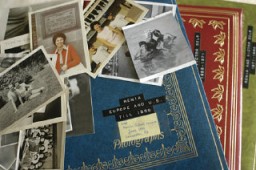You searched for: %E5%8D%A1%E5%A1%94%E5%B0%94%E4%B8%96%E7%95%8C%E6%9D%AF%E8%B5%9B%E7%A8%8B%E6%97%B6%E9%97%B4%E8%A1%A8%E3%80%90%E6%89%8B%E5%8A%A8%E8%BE%93%E5%85%A5%E2%88%B6___bet126.net___%E3%80%91%E4%BA%9A%E6%B4%B2%E6%9C%80%E5%A4%A7%E5%8D%9A%E5%BD%A9%E5%85%AC%E5%8F%B8%E5%AE%89%E5%85%A8%E7%A8%B3%E5%AE%9A%E6%9E%81%E9%80%9F%E5%87%BA%E6%AC%BE%E6%9C%89%E4%BF%9D%E9%9A%9C%EF%BC%81
<< Previous | Displaying results 101-150 of 168 for "%E5%8D%A1%E5%A1%94%E5%B0%94%E4%B8%96%E7%95%8C%E6%9D%AF%E8%B5%9B%E7%A8%8B%E6%97%B6%E9%97%B4%E8%A1%A8%E3%80%90%E6%89%8B%E5%8A%A8%E8%BE%93%E5%85%A5%E2%88%B6___bet126.net___%E3%80%91%E4%BA%9A%E6%B4%B2%E6%9C%80%E5%A4%A7%E5%8D%9A%E5%BD%A9%E5%85%AC%E5%8F%B8%E5%AE%89%E5%85%A8%E7%A8%B3%E5%AE%9A%E6%9E%81%E9%80%9F%E5%87%BA%E6%AC%BE%E6%9C%89%E4%BF%9D%E9%9A%9C%EF%BC%81" | Next >>
-
German air campaign in the Low Countries
FilmThe Junkers (Ju) 87, known as the "Stuka," spearheaded the Blitzkrieg ("lightning war") attacks that were decisive in the western campaign in 1940. Stuka dive-bombers closely supported German ground forces. They destroyed enemy strong points, aircraft, and airfields, and spread panic in rear areas. Although slow and easily shot down by Allied fighters, the Stukas proved devastatingly effective in the German invasions of Poland and western Europe, where Germany enjoyed superiority in the air. Stukas caused…
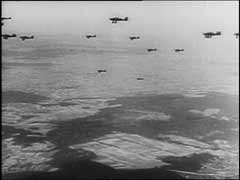
-
Stand Fast
SongErich Frost (1900–87), a musician and devout Jehovah's Witness, was active in the religious resistance to Hitler's authority. Caught smuggling pamphlets from Switzerland to Germany, he was imprisoned in the Sachsenhausen concentration camp near Berlin where he composed this song in 1942. Later deported to a labor camp at Alderney, Channel Islands, Frost survived the war and returned to Germany to serve the Watchtower Society. "Fest steht," reworked in English as "Forward, You Witnesses," is among the…
-
Book Burning
ArticleBook burning is the ritual destruction by fire of books or other written materials. The Nazi burning of books in May 1933 is perhaps the most famous in history. Learn more.

-
"Kristallnacht": nationwide pogrom
MapKristallnacht—literally, "Crystal Night"—is usually translated from German as the "Night of Broken Glass." It refers to the violent anti-Jewish pogrom of November 9 and 10, 1938. The pogrom occurred throughout Germany, which by then included both Austria and the Sudetenland region of Czechoslovakia. Hundreds of synagogues and Jewish institutions all over the German Reich were attacked, vandalized, looted, and destroyed. Many were set ablaze. Firemen were instructed to let the synagogues burn but to…

-
Columbia-Haus
ArticleThe Columbia-Haus camp was one of the early camps established by the Nazi regime. It held primarily political detainees. Learn more about the history of the camp.
-
Dismissal letter from the Berlin transit authority
DocumentA letter written by the Berlin transit authority (Berliner Verkehrs Aktiengesellschaft) to Viktor Stern, informing him of his dismissal from his post with their agency as of September 20, 1933. This action was taken to comply with provisions of the Law for the Restoration of the Professional Civil Service. On April 7, the German government issued the Law for the Restoration of the Professional Civil Service (Gesetz zur Wiederherstellung des Berufsbeamtentums), which excluded Jews and political opponents…

-
Auschwitz Through the Lens of the SS: Frankfurt Trial
ArticleKarl Höcker’s album shows him in close contact to the main perpetrators at Auschwitz-Birkenau. Learn about his 1963 trial and the significance of his album.
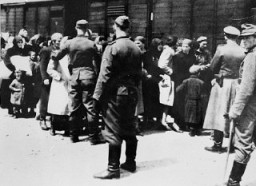
-
Lea Ofner-Szemere
ID CardLea was born in the city of Sombor in northeastern Yugoslavia. When she was 3 years old, her parents divorced and she moved to Vienna with her mother, who taught English and French to Austrian children. Lea enjoyed living in Vienna as a child. 1933-39: Lea returned to Sombor almost every year to visit her mother's relatives. There, she became reacquainted with her younger half-sister, Julia, and her older half-brother, Francis, and would miss them when she returned to Vienna. In 1938, the Germans annexed…

-
Elie Wiesel
ArticleElie Wiesel was a human rights activist, author, and teacher who reflected on his experience during the Holocaust in more than 40 books. Learn more.

-
Hermann Ludwig Maas
ArticleHermann Ludwig Maas, a Protestant pastor in Heidelberg, Germany, was a rescuer and clergyman who stood in solidarity with the Jewish community.
-
Dr. Robert Ritter visits a "Gypsy camp"
PhotoDr. Robert Ritter talks to several residents in a Zigeunerlager ("Gypsy camp"). Hamburg, Germany, 1940. During the Nazi era, Dr. Robert Ritter was a leading authority on the racial classification of people pejoratively labeled “Zigeuner” (“Gypsies”). Ritter’s research was in a field called eugenics, or what the Nazis called “racial hygiene.” Ritter worked with a small team of racial hygienists. Among them were Eva Justin and Sophie Ehrhardt. Most of the people whom Ritter studied and…

-
Eva Justin interviews a Romani woman interned in a "Gypsy camp"
PhotoA color photograph of Eva Justin interviewing a Romani woman interned in a "Gypsy camp." Vienna, Austria, 1940. During the Nazi era, Dr. Robert Ritter was a leading authority on the racial classification of people pejoratively labeled “Zigeuner” (“Gypsies”). Ritter’s research was in a field called eugenics, or what the Nazis called “racial hygiene.” Ritter worked with a small team of racial hygienists. Among them were Eva Justin and Sophie Ehrhardt. Most of the people whom Ritter studied and…

-
A family interned in a "Gypsy camp"
PhotoA family stands outside of their wagon while interned in a Zigeunerlager ("Gypsy camp"). In the background, children are crowded around Eva Justin. Justin worked for the Center for Research on Racial Hygiene and Demographic Biology. Schleswig-Holstein, Germany, 1938. During the Nazi era, Dr. Robert Ritter was a leading authority on the racial classification of people pejoratively labeled “Zigeuner” (“Gypsies”). Ritter’s research was in a field called eugenics, or what the Nazis called…

-
Abdol Hossein Sardari (1895–1981)
ArticleIranian diplomat Abdol Hossein Sardari gave critical assistance to Iranian Jews in occupied France (1940-1944) to protect them from Nazi persecution.
-
SS and Police
ArticleDuring World War II, SS and police leaders played a key role in the mass murder of Europe’s Jews. Learn how Himmler combined the SS and police to create a radical weapon for the Nazi regime.

-
Theresienstadt: Final Weeks, Liberation, and Postwar Trials
ArticleThe Theresienstadt camp-ghetto existed from 1941 to 1945. Learn about its final weeks, liberation, and the postwar trials of SS commandants and other staff.
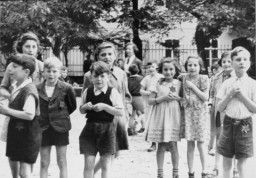
-
1938: Key Dates
ArticleExplore a timeline of key events in the history of Nazi Germany during 1938.

-
The SA
ArticleThe SA (Sturmabteilung) was a paramilitary organization integral to Hitler’s ascension to power. Learn more about the rise and fall of the SA.

-
Kristallnacht
Timeline EventNovember 9, 1938. On this date, the Nazi regime coordinated a wave of antisemitic violence in Nazi Germany. This became known as Kristallnacht or the "Night of Broken Glass."

-
Lend-Lease
ArticleLearn more about the Lend-Lease Act, which was the American policy that extended material aid to the WWII Allied powers from 1941-1945.

-
The 69th Infantry Division during World War II
ArticleThe 69th Infantry Division participated in major WWII campaigns and is recognized for liberating the Leipzig-Thekla subcamp of Buchenwald in 1945.
-
Lithuania
ArticleAs part of the Holocaust, the Germans murdered about 90% of Jews in Lithuania. Read more about the tragic experience of Lithuanian Jews during World War II.

-
Terez Goldberger Kalman
ID CardTerez came from a religious Jewish family. She and her husband, Samuel, raised eight children in Satoraljaujhely, in northeastern Hungary. The Kalmans lived on the outskirts of the city, and in the 1920s they ran a canteen for the soldiers who lived in the nearby barracks. The Kalmans were proud Hungarians; one of their sons had died in World War I. 1933-39: Since Samuel died a few years ago, Terez has been alone here in her house in Satoraljaujhely. Many of her children live nearby, though, so her home…
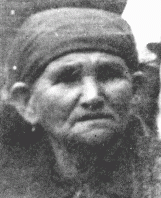
-
Life After the Holocaust: Norman Salsitz
ArticleAfter WWII and the fall of the Nazi regime, Holocaust survivors faced the daunting task of rebuilding their lives. Listen to Norman Salsitz's story.
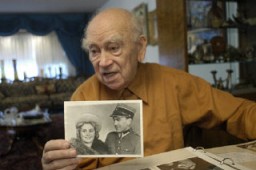
-
Buchenwald
ArticleThe Nazi regime established the Buchenwald camp in 1937. Learn about the camp’s prisoners, conditions there, forced labor, subcamps, medical experiments, and liberation.

-
Brandenburg T4 Facility
ArticleBrandenburg was one of six killing centers the Nazis established to murder patients with disabilities under the so-called "euthanasia" program.
-
Nazi Persecution of Jehovah's Witnesses
ArticleJehovah's Witnesses were subjected to intense persecution under the Nazi regime. Read more to learn why and how the Nazi regime targeted them.

-
Theresienstadt
ArticleThe Theresienstadt camp/ghetto served multiple purposes during its existence from 1941-45 and had an important propaganda function for the Germans. Learn more.

-
Aliyah Bet
ArticleLearn more about Aliyah Bet, the clandestine immigration of Jews to Palestine between 1920 and 1948, when Great Britain controlled the area.

-
Persecution of Roma (Gypsies) in Prewar Germany, 1933–1939
ArticleBeginning in 1933, the Nazis persecuted Roma (often pejoratively called “Gypsies”) based on underlying prejudices and racism. Learn how this harassment escalated to genocide.

-
Ban on Jehovah's Witness Organizations
Timeline EventApril 1, 1935. On this date, the German government banned all Jehovah's Witness organizations.

-
International Military Tribunal: The Defendants
ArticleListing of the 24 leading Nazi officials indicted at the International Military Tribunal at Nuremberg. Learn about the defendants and the charges against them.
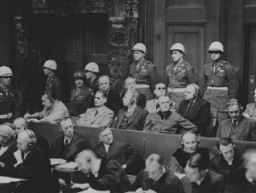
-
Elie Wiesel Timeline and World Events: 1928–1951
ArticleSurvivor Elie Wiesel devoted his life to educating the world about the Holocaust. Learn about key events in the world and his life from 1928–1951.

-
Hermann Göring: Key Dates
ArticleHermann Göring held many positions of power and leadership within the Nazi state. Learn about key dates in the life of Hermann Göring.
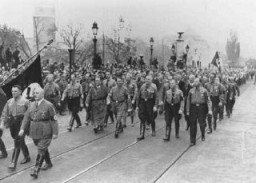
-
Forced Labor: In Depth
ArticleForced labor, often pointless, humiliating, without proper equipment, clothing, nourishment, or rest, was a core feature in the Nazi camp system from its beginnings in 1933.

-
Air war in Flanders: Western Campaign
FilmThe Junkers (Ju) 87, known as the "Stuka," spearheaded the Blitzkrieg ("lightning war") attacks that were decisive in the western campaign in 1940. Stuka dive-bombers closely supported German forces on the ground. They destroyed enemy strong points, aircraft, and airfields, and spread panic in rear areas. Although slow and easily shot down by Allied fighters, the Stukas proved devastatingly effective in the German invasions of Poland and western Europe, where Germany enjoyed air superiority. Stuka…

-
Voyage of the St. Louis
ArticleIn May 1939, the German transatlantic liner St. Louis sailed from Germany to Cuba. Most of the passengers were Jews fleeing Nazi Germany. Learn more about the voyage.

-
Peter Black describes the role of historians in researching war crimes cases for OSI
Oral HistoryIn the 1980s and 1990s, historian Peter Black worked for the US Department of Justice Office of Special Investigations, as part of a team tracking and prosecuting suspected war criminals. Black later served as the Senior Historian at the United States Holocaust Memorial Museum.
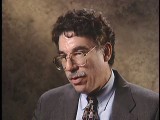
-
Freiberg
ArticleLearn about the Freiburg subcamp of Flossenbürg, including its establishment, prisoner population, and conditions there.
-
Aron Tabrys
ID CardAron was the second of six children born to Jewish parents in Vilna, a city known as a center of Jewish cultural life. He was called Arke by his friends and family. Aron's father supported his large family on the meager income of a chimney sweep. 1933-39: As a child Aron attended a Jewish day school, and then went on to attend a public secondary school. When he was 14 his father had an accident which rendered him blind, and Aron had to start working full-time to support the family. Aron belonged to an…

-
Eva Gredinger
ID CardEva was one of three children born to Jewish parents in Vertujeni, a Bessarabian town that was 90 percent Jewish. Eva attended a public school. Her family was religious, attending synagogue every day. Eva's father made his living as a kosher butcher, preparing chicken according to Jewish dietary laws. 1933-39: In 1936, when Eva was 15 years old, her family moved to Vysoka, where she later got a job as a seamstress. Vysoka was very different from her hometown. There were only about 15 Jewish families in…

-
Janusz Piotrowski
ID CardJanusz was the eldest of four children born to Catholic parents in Plock, a town located in a rural area north of Warsaw. His father was an accountant. Janusz attended local schools, and became active in scouting. 1933-39: Janusz went to Warsaw to study civil engineering. On September 1, 1939, the Germans began bombing Warsaw. One week later, all able-bodied men who had not been mobilized were directed to retreat east. On September 17, Janusz was 90 miles from the Romanian border. That night, the Soviets…

-
Tomasz (Toivi) Blatt
ID CardTomasz was born to a Jewish family in Izbica, a Polish town whose largely religious Jewish community comprised more than 90 percent of the population. Tomasz's father owned a liquor store. 1933-39: In September 1939, a drum sounded in the marketplace, calling the town to assemble for a news report. Germany had invaded Poland. More news arrived shortly; the Soviet Union was invading from the east. Tomasz and his family didn't know what to do. Some people said to run to the Soviet side; many, including his…

-
William Denson describes postwar trials of concentration camp personnel
Oral HistoryWilliam Denson graduated from the US Military Academy at West Point in 1934 and attended Harvard Law School. He returned to West Point to teach law from 1942 until 1945. In January 1945, Denson accepted the position of Judge Advocate General (JAG) in Europe and was assigned to US Third Army headquarters in Germany. He took part in more than 90 trials against Germans who had committed atrocities against downed American pilots. In August 1945, Denson became chief prosecutor for the US government at the…

-
William Denson describes counsel provided to accused war criminals
Oral HistoryWilliam Denson graduated from the US Military Academy at West Point in 1934 and attended Harvard Law School. He returned to West Point to teach law from 1942 until 1945. In January 1945, Denson accepted the position of Judge Advocate General (JAG) in Europe and was assigned to US Third Army headquarters in Germany. He took part in more than 90 trials against Germans who had committed atrocities against downed American pilots. In August 1945, Denson became chief prosecutor for the US government at the…

-
William Denson describes finding witnesses for the postwar trials of concentration camp personnel
Oral HistoryWilliam Denson graduated from the US Military Academy at West Point in 1934 and attended Harvard Law School. He returned to West Point to teach law from 1942 until 1945. In January 1945, Denson accepted the position of Judge Advocate General (JAG) in Europe and was assigned to US Third Army headquarters in Germany. He took part in more than 90 trials against Germans who had committed atrocities against downed American pilots. In August 1945, Denson became chief prosecutor for the US government at the…

-
The Search for Perpetrators
ArticleThousands of Nazi criminals were never arrested. Learn more about the postwar efforts to bring Nazi perpetrators to justice.

-
Melk
ArticleLearn about the establishment of and conditions in Melk, a subcamp of the Mauthausen camp system in Austria.

-
Westerbork
ArticleThe Westerbork transit camp, located in the German-occupied Netherlands, served as a temporary collection point for Jews in the Netherlands before deportation.

-
Life After the Holocaust: Regina Gelb
ArticleAfter WWII and the fall of the Nazi regime, Holocaust survivors faced the daunting task of rebuilding their lives. Listen to Regina Gelb's story.
